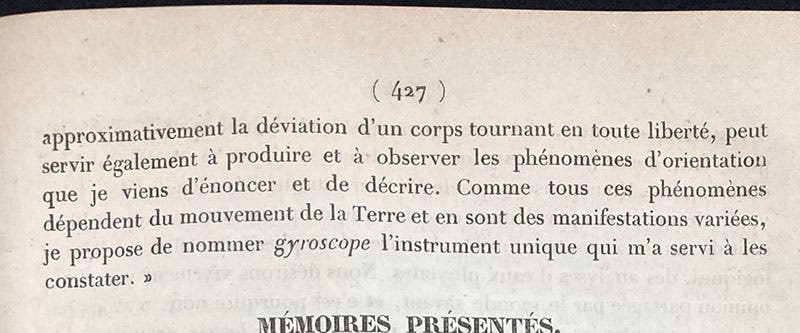Scientist of the Day - Leon Foucault
Léon Foucault, a French physicist, was born Sep. 18, 1819, in Paris. He was one of the most ingenious experimental physicists France ever produced, measuring the speed of light, inventing a reflecting telescope with a silvered mirror, devising a "knife-edge test" for spherical or parabolic mirrors that helps make fine corrections to their curvature, and, of course, demonstrating the rotation of the Earth with a pendulum hung from the dome of the Panthéon, the eponymous experiment for which he is best known. We discussed Foucault's pendulum in our first post on Foucault.
The problem with Foucault's pendulum as a demonstration is that there are not many places you can hang a 200-foot pendulum with a 60-pound bob. So Foucault looked for another, less grand way to demonstrate the Earth's rotation, and he found it in the gyroscope, which is just a rotating disk mounted on gimbals, which allows the axis to point in any direction whatsoever. But if you rotate the disk rapidly, building up what we now call its angular momentum, then the axis continues to point in the same direction in space, no matter how you rotate the gimbals. Foucault did not invent the gyroscope – several other people, a German and an American, had a hand in that. But no one knew what to do with it, until Foucault.
Foucault surmised that if you could greatly reduce the friction at the pivot points of the axis, remove most of the weight on the lower pivot by suspending the gimbals, and make the disk rotate at a very high speed, then you might generate a spin that would last for ten minutes or more. This would be plenty of time to produce a measurable change in the orientation of the axis with respect to the Earth. Foucault made his suggestion in a paper published in 1852, one year after his pendulum demonstration. Actually, he published two papers, back to back, one on the implications of the gyroscope for astronomy (third image) , and another on its use in physics (fourth image), especially for demonstrating precession, where you apply a force to the gyroscope axis, and it responds by moving in a direction at right angles to the applied force. Of course, you can make the same point with a spinning top - that is why the top does not fall over – but it seems more counterintuitive with the gyroscope.

First paragraph, "Mécanique: Sur les phénomènes d'orientation des corps tournants entraînés par un axe fixe à la surface de la Terre. Nouveaux signes sensibles du mouvement diurne," by Léon Foucault, Comptes rendus hebdomadaires des séances de l'Académie des Sciences, 1852, vol. 35, p. 424 (Linda Hall Library)
In his second paper, Foucault also coined the name gyroscope in the very last sentence, which I thought I would show you (fifth image).

Coining the word gyroscope for his new device, "Mécanique: Sur les phénomènes d'orientation des corps tournants entraînés par un axe fixe à la surface de la Terre. Nouveaux signes sensibles du mouvement diurne," by Léon Foucault, Comptes rendus hebdomadaires des séances de l'Académie des Sciences, 1852, vol. 35, p. 427 (Linda Hall Library)
Foucault had a machinist friend produce several tabletop gyroscopes (first and last images), and soon they were in production for physics labs all around the world. A professor of physics at Kenyon College has, over the past 50 years, visited most of the Physics Departments in the eastern U. S. and asked them to bring out their vintage demonstration equipment, which he has photographed and assembled into a visual catalog, one webpage of which is devoted to Foucault gyroscopes. We show one of those here (sixth image), and you can see others on this webpage. Most were made in Paris and imported by U.S. firms, many of which slapped their own nameplates on the gyros they sold.
There is another original Foucault gyroscope on display at the Conservatoire national des arts et métiers in Paris (seventh image); the instrument itself is not very well shown, but you can see the microscope that was used to measure the slow drift of the gimbals, caused by the rotation of the Earth. Foucault gyroscopes, with their ability to align with a fixed point in space, later turned out to be of fundamental importance for navigation, first in dirigibles, airplanes, and submarines, then in missiles and bombs, and finally in spacecraft.
As we mentioned in our first post, Foucault's experimental genius continued to flower until the mid-1860s, when he was suddenly cut down by a rapid onslaught of what is believed to have been multiple sclerosis. He died on Feb. 11, 1868, just 48 years of age, and was buried in Montmarte Cemetery in Paris.
There are many studio portraits of Foucault, and they are all appealing, at least to me, as he looks so calm and wise, and a little resigned, almost as if he knew of the curveball life was about to throw at him. We showed a portrait from our own collection in our first post; here we show another, a carte de visite in the Bibliothèque nationale in Paris (second image).
William B. Ashworth, Jr., Consultant for the History of Science, Linda Hall Library and Associate Professor emeritus, Department of History, University of Missouri-Kansas City. Comments or corrections are welcome; please direct to ashworthw@umkc.edu.










